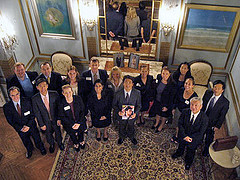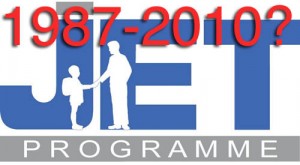JET ROI: MOFA State Secretary Mr. Koichi Takemasa’s comments upon meeting with JETAA members
Ministry of Foreign Affairs (MOFA) State Secretary Mr. Koichi Takemasa recently met with a group of JET alumni in New York to learn first hand about JET and the JET Alumni Association. Following the meeting, State Secretary Takemasa posted comments regarding the meeting on both the MoFA website as well as on his own blog. Below is a translation of key comments from the posts. (Special thanks to Kumi Mastsumoto of the Consulate for her help in obtaining the translations):
1. MOFA Website Comments
From the official report of State Secretary Takemasa’s visit to the United States on MoFA’s website. (Full link here: http://www.mofa.go.jp/mofaj/annai/honsho/fuku/takemasa/usa_10/gaiyo.html):
2. (6) 日米人物・文化交流
特にこれまでのJET出身者が米国内で対日理解や日米交流の発展に果たしている役割について積極的な評価を共有。English translation of the last sentence of Section 2, Paragraph (6): “We both positively recognized that JET returners have contributed to promoting understanding of Japan in the US and fostering people to people exchange between the two countries.”
2. Personal Blog of Koichi Takemasa
 Here is what Secretary of State Takemasa wrote about his meeting with JETAA members on his personal blog (link to post: http://takemasa.asablo.jp/blog/2010/07/17/5237531):
Here is what Secretary of State Takemasa wrote about his meeting with JETAA members on his personal blog (link to post: http://takemasa.asablo.jp/blog/2010/07/17/5237531):
その後、JETの経験者で作られるJETAAのNY支部の皆さんと意見交換。 JET通じて得たもの、帰国後それを伝えていること、また、新しいJETメンバーの選考や送り出しに協力をしていること。そして、事業仕分けで総務所所管のクレアが対象になったことで、JET制度そのものの存続に危機感を持っていること、などを聞く。
“I had a meeting with the members of JET Alumni Association in New York . There, I heard comments about how much they learned from the JET experience, how they have been sharing their experience to others after they came back and how they have been cooperating in the screening and training process of the new JETs. Referring to the fact CLAIR (JLGC) under Ministry of Internal Affairs and Communications was put on the chopping block, they showed their strong concern in the future of JET program.”
*********
JET Return on Investment (ROI) is a category on JetWit intended to highlight the various economic, diplomatic and other benefits to Japan resulting from its investment in the JET Program. Why is this important right now? Because the JET Program and JET Alumni Association may be cut by the Japanese government, as explained in this post by Jim Gannon (Ehime-ken, 1992-94) titled “JET Program on the Chopping Block.”
The Japan Times just ran an article worth reading on the debate over the value of the JET Programme in the face of potential budget cuts titled “Ex-students don’t want JET grounded: Eric Johnston and Kanako Nakamura ask ‘children of JET’ whether the program deserves to be on the chopping block.” (Here’s the URL: http://search.japantimes.co.jp/cgi-bin/fl20100727zg.html)
The article does a nice job of highlighting the main schools of thought in the public discussion about the JET Programme (and by association, the JET Alumni Association). But it also falls into the “he said/she said” trap by laying out anti-JET arguments that miss the bigger picture or are based on false assumptions. That said, hearing these is helpful to understanding how JET is perceived by many people, including Japanese taxpayers.
The article is also the first I’ve seen (there may be others) that attempts to give voice to one of the primary constituents of the JET Programme: students in Japan.
In attempting to analyze this situation, the first thing to be aware of is that JET has a dual purpose:
- Teach English and promote “internationalization” in Japan.
- Help Japan promote positive foreign relations, diplomacy, business and cultural exchange and outreach with the rest of the world.
1. English Teaching
With regard to English teaching and “internationalization” in Japan, the article is correct that it’s a difficult thing to quantify. However, making English test scores by Japanese students a basis for evaluating the benefit of JET is comparing apples and oranges. JET never had the mandate to improve test scores. If anything, we were there to teach “living English” which doesn’t get tested for. And also to inspire students to connect with English and gain valuable experience interacting with people from other cultures.
In that vein, perhaps a more important aspect to track and focus on is the number of students who went on to gain greater proficiency in English or travel and work abroad over the past 22 years, giving Japan a stronger, more internationally-savvy workforce. Japan doesn’t need every student to become proficient in English. Just some percentage that will help lift Japan’s abilities over time and perhaps even become a source of more fluent-speaking English teachers over time.
I talk to a lot of JET alums, and I hear so many stories of students who have kept in touch, of students who have gone on to great achievements as a result of their access to JETs. And also many JETs who have maintained relationships with their towns, have helped continued exchanges and given back to their communities in a variety of ways. Just because you don’t hear all of the stories doesn’t mean they’re not happening, because they most certainly are. (The most visible example, perhaps, is Anthony Bianchi (Aichi-ken, 1987-89) who is now a city councilman in Inuyama-shi, Aichi-ken where he previously taught on JET.)
2. Foreign Relations and JET Alumni
On the second count, there’s not really a counter argument to even make. JET alumni have provided (and continue to provide) a huge return on Japan’s initial investment in them as JETs. JET alumni have written books about Japan and work for many Japanese companies and organizations, including Japanese Consulates and Japan-America socieites. JET alumni are major feeders into Japan-oriented academic fields. JET alumni invest in Japan and start Japan-related (and Japan-located) businesses. And many JET alumni are now in major government and policy positions in their countries.
As an alumni organization, the JET Alumni Association (JETAA) is young at only 22 years old. As the community matures, the value, influence and impact of JET alumni for Japan will continue to grow at an increasing rate as more and more JET alumni become experts and are established in their fields.
Additionally, with a population of over 50,000 worldwide, JET alumni help provide a sort of substitute ex-pat community that Japan has lacked in comparison to the United States and other countries. Contrary to the assertion in the Japan Times article that JET alums are taking away jobs from Japanese people, JETs are providing huge economic benefits to Japan. For example, after 9/11 when getting work visas became harder for ex-pats in the U.S., Japanese staffing agencies began seeking out more JET alums to fill positions, as they were the best alternative option to filling roles in Japanese offices in the U.S. Additionally, JET alums constantly find themselves in facilitating roles, helping their companies navigate cross-cultural communication issues. Bi-culturalism can be an extremely valuable skill.
JETAA is also perhaps the cheapest and most efficient and effective public relations arm the Japanese government could hope to have. JETAA chapters everywhere are constantly organizing cultural outreach events and providing volunteers for Japan Days, Japan-related festivals and other cross-cultural events like the Japanamania event JETAA New York does with the local Big Brother/Big Sister chapter. For a good sense of JETAA chapter activities around the globe, just read a few of the “JETAA Chapter Beat“ posts by Jonathan Trace (Fukuoka-ken, 2005-08). I saw a comment posted on a blog cynically suggesting that if Japan really wanted PR, it would hire a PR firm to place ads in the New York Times. Believe me, a PR firm cannot produce the kind of grassroots positive publicity and loyalty that the JET Alumni Association continues to provide.
What I’ve written above is a small summary, the tip of the iceberg, of the kinds of things going on. Thanks to JET and JETAA, Japan has an army of committed ex-pats around the world (including in Japan) who feel a strong connection to Japan and care deeply about the country and the people. To cut this goodwill off at the roots would do far more harm to Japan than any benefit resulting from saving a few dollars.
To learn more, get in touch with your local JETAA chapter, read various posts on JetWit.com or do your own research. (I’m always happy to use JetWit as a platform for reaching out to JET alums and gathering stories, anecdotes and other hard to gather information.)
I’m sure I’ve overlooked a number of additional good points and examples. Please feel free to make them in the comments section below.
JETs with J.D.s >> The New Interviewing Buzzword: Emotional Intelligence
Andrew R. McCarthy (Akita-ken, 2005-08) is a law student at The Ohio State University Moritz College of Law focusing on international trade, business, and tax. He currently runs the blog JETs with J.D.s, an information source for current JET alumni law students and prospective law students for career paths and approaches within the current legal market. For those considering law school and trying to comprehend the costs and the risks of such an endeavor, he also recommends The Law School Tuition Bubble.
You may not have to channel Miss Cleo to get legal employment these days. But, in addition to the healthy dose of luck you’ll need, the legal career services world has created a brand new buzzword concept through which all prospective employees can be vetted: emotional intelligence. What is emotional intelligence, you ask? Emotional intelligence, or as those trying to sound more professional than they really are might call it, “EI,” is the demonstrated ability to show, and practice, professional competence by providing good answers to hypothetical questions and connecting with interviewers. The idea behind the concept is that you are being hired not just for your legal acumen and ability to detect italicized commas in a document of hundreds of pages — you’re being hired to develop and maintain clients. What does this all boil down to? What help, if any, does a JET background provide? Is law school even conducive to developing “emotional intelligence?”
All those answers (or at least educated guesses) are right here.
Job: Keio Academy – Dormitory Supervisor (NY)
Via the JETAAJOB Yahoo listserv:
POSITION: F/T DORMITORY SUPERVISOR (BOYS DORMITORY)
QUALIFICATIONS: Must have bachelor’s degree. Must reside on campus. Several years of experience in resident adviser duties in residence halls at educational institutions preferred. Education Science, counseling or psychology background is a plus.
Starting Date: August 20, 2010
COMPENSATION: Salary commensurate with education and experience. Health Insurance, 403B Pension Plan benefits for Full-time position.
DEADLINE: Applications will be considered in order of arrival, until the position is filled.
TO APPLY: Send designated application form (http://www.keio.edu/english/employment), letter of interest and resume to:
Keio Academy of New York
attn: Human Resources
3 College Rd.
Purchase, NY 10577
or e-mail to: somu@keio.edu
FAX: (914) 694-4830
WIT Life #110: Japan Cuts comes to a close
WITLife is a periodic series written by professional Writer/Interpreter/Translator Stacy Smith (Kumamoto-ken CIR, 2000-03). She starts her day by watching Fujisankei’s newscast in Japanese, and here she shares some of the interesting tidbits and trends together with her own observations.
Last Friday wrapped up Japan Cuts, the two-week, 25-film festival at Japan Society. Thanks to JS’s wonderful volunteering system I was able to see nine of the films at the festival itself, and another two in the comfort of my home. The final night wrapped up the event with the two movies About Her Brother and Sweet Little Lies. I was really looking forward to the latter, but I found the pacing slow and the movie’s story less stimulating than I thought it would be.
About Her Brother is one of those ubiquitous sentimental Japanese movies, but it wasn’t too heavy on the sappiness. Tsurube Shofukutei plays Read More
JET ROI: Hawaii News Now interviews Hawaii JET alums about possible budget cuts to JET and JETAA
Here’s a link to two short interviews with JET alums Kelsey Soma Turek (current JETAA Hawaii President) and Darr yl Toma (JETAA Hawaii Vice-President) regarding the possibility of budget cuts to JET and JETAA that appeared on the TV show Hawaii News Now: http://www.hawaiinewsnow.com/Global/story.asp?S=12805830
yl Toma (JETAA Hawaii Vice-President) regarding the possibility of budget cuts to JET and JETAA that appeared on the TV show Hawaii News Now: http://www.hawaiinewsnow.com/Global/story.asp?S=12805830
Additionally, here’s a post about the interviews by Kelsey on the JETAA Hawaii website: http://jetaahawaii.org/2010/07/16/hawaii-takes-action-on-possible-jet-program-cuts/
Note: I believe the videos will only be available on the HNN site for another week or so.
JETs with J.D.s >> Judicial Clerking in the Tropics
Andrew R. McCarthy (Akita-ken, 2005-08) is a law student at The Ohio State University Moritz College of Law focusing on international trade, business, and tax. He currently runs the blog JETs with J.D.s, an information source for current JET alumni law students and prospective law students for career paths and approaches within the current legal market. For those considering law school and trying to comprehend the costs and the risks of such an endeavor, he also recommends The Law School Tuition Bubble.
Former JETs naturally have a little bit of adventurer in them. Unfortunately, the sedentary life of the law student spells disappointment for those of accustomed to a more active life. This isn’t to say going out and enjoying life doesn’t happen in law school. But if you like inordinate amounts of time reading and editing italicized commas, however, you’re in for a real treat.
Fortunately, life after law school doesn’t necessarily have to be like that — and if you still have that glimmer of a sense of adventure and the desire to live in not-so-often traveled parts of the world, a judicial clerkship in on of America’s international territories might be what you’re after.
To read information regarding clerkships available in Palau, click here.
For those interested in American Samoa, here.
For those interested in clerking for the Northern Mariana Islands, information is available here.
JETAA Chapter Beat – JETAA Hawaii Enkai Experience Writeup
Jonathan Trace (Fukuoka-ken, 2005-08) follows up on JETAA Chapter Beat with a report from the Experience Enkai put on by JETAA Hawaii.
Sashi-bashi, hotoke-bashi, hashi-watashi…these were just some of the chopsticks taboos learned at the annual Experience Enkai at Natsunoya Tea House on Friday, July 9, 2010 from 6:00 – 9:30 p.m. Seventeen JET alumni graciously imparted their Japanese etiquette wisdom on the ten new JETs who attended the event. JETAA officers began the program with having everyone pick numbers for their seating arrangements (in Japanese enkai style), followed by an overview of enkai etiquette and a beer-pouring demonstration. Everyone then practiced the art of beer-pouring for one another in time for the kampai by JETAA Hawaii President Kelsey Soma Turek. Then the feast began.
The staff at Natsunoya kept bringing out dish after dish of sushi, somen salad, tonkatsu, agedashi tofu, beef sticks, and salmon to name a few. With full stomachs and lots of empty bottles of Kirin beer, oolong tea, and Calpico, it was time for jiko shoukai (self-introductions). Everyone did so well speaking in Japanese (did the alcohol help?)! After that, we let the games begin! JETAA officers divided everyone into groups for the infamous Forehead Game and Draw-on-your-Head Game! Luckily we were able to capture the hilarious moments here. After prizes were awarded to 1st, 2nd, 3rd, and 4th place teams (congratulations everyone!), we ended the night with group photos and saying our good-byes. We hope this event has helped prepare the new JETs for their time on the JET Program. Good luck to all of you, and please stay in touch! Thank you to Liane and the Natsunoya staff for taking care of us that evening, and of course, thank you to everyone who attended the event! –JETAA Hawaii
What happened at your chapter’s event? If you attend(ed) any exciting JETAA events, JetWit would love to hear about them. Just contact Jonathan Trace with any info, stories or comments.
Freelance writer/editor Jonathan Trace (Fukuoka-ken, 2005-08) takes us on a walk around the JET Alumni community for another edition of JETAA Chapter Beat.
- Picnic in the Park – Saturday, July 31st, 12:00 at Holland Park. JETAA London will be spending the day in Holland Park’s Kyoto Garden.
- Summer Picnic – Sunday, August 1st, 11:00 to 4:00 at Carkeek Park, Shelter 2. Get out in the sun for a day of food, fun and games with PNWJETAA. Events this year will follow an Undoukai theme, with traditional Japanese games and a few new ones as well.
- DrumSTRONG 3 – Friday, August 6th, 7:30 at the Neurosciences Institute Auditorium in San Diego. The Japan Society of San Diego and Tijuana are hosting Drumstrong 3, the third in a series of cross-cultural drumming concerts produced by San Diego Taiko. This year features Leilsa, a San Diego based Tahitian drum and dance group.
- Pre-Departure Reception – Friday, July 30th, 4:00 to 7:00 at the Residence of the Consul General. Pass along some final advice as the 2010 JETs prepare to embark on their journey to Japan.
- Pre-Departure Reception – Friday, July 30th, 6:30 to 8:00 at the Embassy of Japan. Bid fond farewell’s and ganbatte’s to the new crop of JETs as they prepare to leave for Japan.
What happened at your chapter’s event? If you attend(ed) any of these exciting events, JetWit would love to hear about them. Just contact Jonathan Trace with any info, stories or comments.
JET ROI: JET Program Alums, Allies Mount Petition Campaign
By JQ Magazine’s Justin Tedaldi (CIR Kobe-shi, 2001-02) for Examiner.com. Visit his NY Japanese Culture page here to subscribe for free alerts on newly published stories.
Since 1987, the Japan Exchange and Teaching (JET) Program has hired over 50,000 native English speakers to work at Japanese public schools, enriching ties between nations. Now, Tokyo’s new ruling political party has JET in its crosshairs in the wake of its effort to slash public spending to reduce its ballooning public debt. In a hearing last May, an 11-person panel of the Democratic Party of Japan ruled unanimously for a comprehensive examination of the program to decide whether it should be scaled back or cut entirely.
JET, an initiative of the Japanese government and run by three of its national ministries, has an annual budget of over $400 million. It was launched with the intentions of increasing grassroots internationalization in Japan, primarily through introducing foreigners to Japanese youth as schoolteachers across the country contracted for a minimum of one year. While the program does not require applicants to be licensed teachers (successful candidates team teach with the host school’s own native Japanese English instructor), they are expected to have an interest in Japan and a desire to integrate themselves in their new communities as cultural ambassadors.
Read the rest of the article here.
Matt Leichter (matt [dot] leichter [at] gmail [dot] com) (Saitama-ken 2003-05) is a renegade attorney who plays by his own rules. He operates his own blog, The Law School Tuition Bubble, where he archives, chronicles, and analyzes the rising cost and declining value of legal education in the United States. He also maintains the “Bankruptcy Legal Topics,” and, “Bankruptcy Billables,” sections for Steven Horowitz’s Bankruptcy Bill. For further reading regarding JETs and the law, he recommends JETs with J.D.s.
I’m not sure, but some JETs who go on to law school choose Temple University, or at its Japan Campus (TUJ) as I did. For those of you who’re Pennsylvanians or contemplating studying law in Pennsylvania, I have for you a Frankensteinian experiment, “Failure to Launch: The Curious Case of Wilkes Law School, PA.”
Tom Baker reviews cat manga, three new films
Tom Baker (Chiba-ken, 1989-91) is a staff writer for The Daily Yomiuri. He usually writes for DYWeekend, the paper’s arts and leisure section. You can follow Tom’s blog at tokyotombaker.wordpress.com. (One recent post is a cautionary tale for anyone thinking of climbing Mt. Fuji.)
Recently he reviewed the manga “Neko Ramen” and the new-in-Japan films “The Road,” “The Yellow Handkerchief” and “Repo Men.” Here are some excerpts:
“Neko Ramen”
 “It’s the one real maverick cuisine of Japan,” Tokyo ramen shop owner Ivan Orkin told The Daily Yomiuri in an interview last year. Sushi and other cuisines are bound by highly refined conventions, but “ramen is the story of a salaryman whose life sucks and he sells everything and opens a ramen shop…he’s going to do it his own way.”
“It’s the one real maverick cuisine of Japan,” Tokyo ramen shop owner Ivan Orkin told The Daily Yomiuri in an interview last year. Sushi and other cuisines are bound by highly refined conventions, but “ramen is the story of a salaryman whose life sucks and he sells everything and opens a ramen shop…he’s going to do it his own way.”
The manga series Neko Ramen, which made its English-language print debut last month, is about a ramen shop owner named Taisho who almost perfectly embodies the ethos Orkin described.
Taisho isn’t a former salaryman–or a man at all. He’s a cat. But he did buck convention to strike out on his own. His father was a top cat-food advertising model, and it was assumed that Taisho would follow in his glamorous footsteps. Instead, he ran away from home.
Even when he is reduced to living on the street, he never loses his independent spirit. Eventually he discovers his calling as the master of a ramen shop.
Mangaka Kenji Sonishi lives in Sapporo, a city noted for its ramen culture. He has given considerable thought to the most egregious ways a bowl of ramen could go wrong, and he has Taisho stumble into each of them.
Read the rest of the review here.
“The Road”
 …We see this world a decade or so into the aftermath [of a global cataclysm] through the eyes of a father and son (Viggo Mortensen and Kodi Smit-McPhee) who are slowly traveling south on foot, hoping things will get better somewhere along the way.
…We see this world a decade or so into the aftermath [of a global cataclysm] through the eyes of a father and son (Viggo Mortensen and Kodi Smit-McPhee) who are slowly traveling south on foot, hoping things will get better somewhere along the way.
It’s a bleak journey, filmed in such genuinely postapocalyptic locales as hurricane-scoured New Orleans and the blasted slopes of Mt. St. Helens.
One of the film’s most desolate images–which can only be appreciated on the big screen–shows a gigantic highway bridge spanning a valley. Seen from below, the bridge cuts a black swath against the murky gray sky. When the man peers over the side of the bridge, the tiny distant speck that is his head is the only thing in the image to show any movement.
The man and the boy’s long walk is a wire-thin plot onto which brief encounters with varied strangers are strung like widely spaced beads.
At the beginning of most such encounters, the boy wants to befriend and help the person, while the man is suspicious. “Why are you following us?” is his angry refrain, even when the person hasn’t been following them. The middle of every encounter is different, but more than one ends with the pair leaving the person behind, the son worrying that the stranger will die and the father remarking, “He was going to die anyway.”
Often the boy needs to ask, “Are we still the good guys?”…
“The Yellow Handkerchief”
 The Yellow Handkerchief begins almost like a silent movie. The first scene shows a man named Brent (William Hurt) being let out of a prison cell. He hardly says a word, but the other inmates wish him a sincerely friendly farewell. His silence continues outside the walls as he watches other newly released inmates embraced by their waiting families. No one is waiting for him. His face shows that he is resigned, and he sets off down the road on foot, alone.
The Yellow Handkerchief begins almost like a silent movie. The first scene shows a man named Brent (William Hurt) being let out of a prison cell. He hardly says a word, but the other inmates wish him a sincerely friendly farewell. His silence continues outside the walls as he watches other newly released inmates embraced by their waiting families. No one is waiting for him. His face shows that he is resigned, and he sets off down the road on foot, alone.
This tells us a few things about him, and gives us a few things to wonder about.
In the next scene, he is sitting in a small-town diner when he notices a dark-haired teenage girl (Kristen Stewart) outside the window. She walks over to a boy of her own age and speaks to him.
Brent (and we) can’t hear her through the glass, but she stands very close to the boy without looking him in the face, suggesting a mixture of intimacy and shyness. The boy ignores her for a moment and then walks away to smile at a blonde girl who welcomes his attention as if it were her due. The dark-haired girl sees this and heads into the diner with a downcast look, alone.
This tells Brent (and us) a few things about her, and gives us a few things to wonder about.
Read the rest of the review here.
“Repo Men”
 The premise of Repo Men is that in the not too distant future, mechanical hearts, livers, kidneys and other organs are so common that they are sold in shopping malls. But they remain so expensive that you have to take out a scarily high-interest loan to get one. And if you miss a few payments, some even scarier repo men (including a pair played by Jude Law and Forest Whitaker) will find you, Tase you, and gruesomely retrieve the property–which is then rinsed off, repackaged and sold to the next sickly dupe.
The premise of Repo Men is that in the not too distant future, mechanical hearts, livers, kidneys and other organs are so common that they are sold in shopping malls. But they remain so expensive that you have to take out a scarily high-interest loan to get one. And if you miss a few payments, some even scarier repo men (including a pair played by Jude Law and Forest Whitaker) will find you, Tase you, and gruesomely retrieve the property–which is then rinsed off, repackaged and sold to the next sickly dupe.
Theoretically, such a setup could have been used to send an allegorical message about the world’s various debt crises or the U.S. health care debate, but the plot is just a heap of sci-fi action cliches.
First, evil corporations control everything. Second, new technology improves material standards of living, but leaves people shallow and soulless. Third, those who oppose or question the new order are fated to live in refugee camps or slums. Fourth, a hunter becomes the hunted, joins the people he once oppressed and does battle against his former colleagues. Fifth, the ending…
Learn Kanji on the iPad with New “Kanji for Fun!” App
JET alum Blaine Leckett (Shimane-ken, 1990-92) has designed a new app for the iPad and available at the iTunes Store for Kanji learners everywhere. With Kanji for Fun! you’ll be remembering your Kanji in no time… and have fun doing it!
Kanji for Fun! is a puzzle game where you match up the Kanji character with its English meaning. There is also a reference section that contains the entire joyo Kanji list. In the reference section you can see the Japanese and Chinese readings and have the ability to practice writing each character with the proper stroke order.
First is the game – A simple yet addictive matching game that will have you pairing Japanese characters to their English meanings in no time. Even if you know nothing about Japanese, just playing in practice mode or sneaking a peek at the game list will greatly increase your Kanji proficiency. And if you’re an expert, try some of the more advanced grades and play with a larger grid.
Second is the reference list – With nearly 2,000 Kanji at your finger tips, take a few quiet moments with your iPad where you can learn new characters, study their readings, or practice writing stroke orders with your finger.
For a limited time, Blaine is offering promo codes so you can try Kanji for Fun! for free. Contact him through his site at http://kanjiforfun.com/support to request a code.
Job: Program Specialist, U.S. Department of Education (Washington D.C.)
Job posting by Lauren Sethney (Niigata-shi CIR, 2000-2003). Lauren serves as the Program Director at the Japan-America Society in Dallas-Fort Worth.
via JETAANY
The Program Specialist position is located in the Department of Education, Office of the Under Secretary, White House Initiative for Asian Americans and Pacific Islanders (WHIAAPI). The Initiative works collaboratively with the White House Office of Public Engagement and the designated Federal agencies to increase Asian American and Pacific Islander (AAPI) participation in programs in education, commerce, business, health, human services, housing, environment, arts, agriculture, labor and employment, transportation, justice, veterans affairs and economic and community development.
This position requires the performance of a variety of program-related assignments. The incumbent reviews, plans, analyzes and develops program requirements, establishes and revises operating procedures, reviews operations, and provides technical assistance. For a complete job description and qualifications, visit http://jobview.usajobs.gov/GetJob.aspx?JobID=89210189&JobTitle=Program+Specialist%2c+GS-301-12%2f13%2f14&where=20230&brd=3876&vw=b&FedEmp=N&FedPub=Y&x=105&y=8&jbf574=ED.
via the JETAA Western Japan Linkedin group:
The Kurashiki Municipal Board of Education in Kurashiki, Okayama is currently accepting applications for one native English teacher to work in junior high school. Applicants must be native English speakers, have lived in Japan for a minimum of 6 months, and possess a university degree. The Board of Education hires instructors directly, and all training is performed in-house.
The contracted employment date begins September 1, 2010 through March, 2011, with the possibility for renewal.
The application deadline in July 23, 2010. Selected applicants must be able to interview in person. Due to the urgent nature of this opening, only applicants currently possessing an Instructor’s visa, Spouse of a Japanese National visa, or Permanent Resident status will be considered.
For more information on the program and to download an application form, please refer to the homepage at: http://www.city.kurashiki.okayama.jp/net/
Questions may be directed to: Ms. Yumi Egi or Ms. Andrea Miyata
net@city.kurashiki.okayama.jp
(086)426-3830






